
Contact

Home

Yahoo - a crude, brutish, or obscenely coarse person
[from the name of a race of brutish creatures resembling men in Jonathan Swift'sGulliver's Travels (1726)]
___________________________________________________________
We cannot find a better conclusion to this week's article, than the report of a monstrosity which is at present the theme of wonder,
as it is of terror, in the neighbourhood of Mangrove. We are credibly informed that several parties have been unexpectedly alarmed
by the sudden appearance of a monster, which they designate a Yaa-hoo (from the noise he makes), who has come upon persons when encamping
at night and to others in the vicinity of their houses, he is described as being nearly seven feet in height, with feet apparently
like human feet, only of enormous size, with his visage turned backwards, and his body covered with apparently a down ; he appears
to be harmless, never having been known to commit violence, and always utters his uncouth Yaa-hoo. There are parties who persist in
stating that he was close to their house in Mangrove, and others who declare to having met him on the road to Wicketty-Wees ! We merely
give the facts as stated to us upon our return, and which upon enquiry, we find firmly persisted in. We recollect hearing of a wild
man once haunting the upper districts in the vicinity of Pitt Town and presume the present to be another of il genus mirabile.
Hairy man:
SYDNEY & BLUE MOUNTAINS
The Sydney Morning Herald (NSW)
Date: July 12, 1843
Page Number: 2
The French translator of Franklin's Correspondence has made a true French blunder. Franklin somewhere says; "People imagined that
an American was a kind of Yahoo. Upon this the translator makes the following note: "Yahoo. It must be an animal. It is affirmed that
it is the opossum, but I have not been able to find the word Yahoo in any dictionary of natural history"!!!--This reminds us of an
anecdote also founded on one of Swift's admirable works:
A gentleman, saw a person poring over an atlas and seemingly disconcerted
by some want of success. "Can't you find what you want" said he "or can I assist you?" - "I don't know (was the reply), for I have
been looking two hours through all latitudes and longitudes and cannot discover this cursed Lilliput anywhere!"
The Hobart Town
Gazette and Southern Reporter (Tas.)
Date: March 11, 1820
Page Number: 2
WAR BY DOUGLAS GERROLD
Launceston Advertiser (Tas.)
Date: January 13, 1844
Page Number: 4

…
Of the character of Shah Mohamod, we have heard that he is a mere Jungleewallah , or "wild man of the woods," who thinks that all
the glory of life consists in fighting according to the practices of savage warfare, he is now pursued by Colonel Roberts who is famed
for his finding out wild boars, and who will not cease to give chase until be discovers the lair.
...
DEFEAT OF SHAH MOHAMOD
South Australian Register (Adelaide, SA)
Date: February 7, 1844
Page Number: 2
…
That a man should kill a man, and rejoice in the deed— nay gather glory from it— is the act of a wild animal. The force of muscle and dexterity of limb, which made the wild man a conqueror, are deemed in savage life man's highest attributes. The creature, whom in the pride of our Christianity we call heathen and spiritually dessolate, has some personal feeling in the strife — he kills his enemy, and then, making an oven of hot stones, bakes his dead body, and, for crowning satisfaction, eats it. His enemy becomes a part of him; his glory is turned to nutriment; and he is content. What barbarism ! Field-marshals sicken at the horror; nay, troopers shudder at the tale, like a fine lady at a toad.
...
Shah Mohammad (1780–1862) was a Punjabi poet who lived during the reign of Maharaja Ranjit Singh and is best known for Jangnama —
a colossal work that gave an eyewitness account of the First Anglo-Sikh War that took place after the death of Maharaja Ranjit Singh.
Shah
Mohammad was a great Punjabi patriot, who infused a sense of nationalism among his readers. His poetry is part of the Punjab's golden
heritage and is considered a lighthouse for the generations to come.

Shah Mohammad may have been a great Punjabi patriot and an inspiration to his people but he was also an enemy of the British Colonial Empire. Note again how “wild man of the woods” is used in a derogatory manner…
Bell’s Life in Sydney and Sporting Reviewer (NSW)
Date: January 3, 1846
Page Number: 1
We observed our good Town fast filling with strangers on the morning of Thursday, all willing to exchange the dreariness of the bush, for a few days recreation. On Friday morning a placard announced a foot and hack race, opposite the Goulburn Inn. At the hour appointed a large assemblage had collected, and the amusements commenced with the Foot Race, the distance being 100 yards, for a contribution from. Mr. Mandolson, and the entrances of 2s. 6d. added ; there were only three competitors, viz., W. Edmonds, William Hall, and W. Wilkinson ; the starting was father against Hall, but this fleet-footed Australian took the Race in gallant style. After which followed the Hack Race for an excellent saddle, presented by Mr. Maudelson, and a bridle for the second horse, presented by Mr. Emanuel. The following horses were entered, the entrance fee being 7s. 6d.
J. Smythe's................. Betsy Bedlam
A. Lawless'.................. Beverly
E. Duffey's............. Jackey Jackey
Mandelson's.............. Blucher
W. Payne's............. Bawley
T. Joseph's.............Hairy Man
S. Davies'........... Warricle
L. Mandelson's............ Piebald
The starting place being at Thorne's fence, and the winning post at the Bridge.
Dead heat between Beverley and Jackey Jackey, closely followed by Hairy Man, the rest "no where."
...
WHAT IS IT ?
Launceston Examiner (Tas.)
Date: January 20, 1847
Page Number: 6
An animal, so singular in its characteristics as to baffle the ingenuity of its exhibiters to classify it, was lately exhibited at the Egyptian Hall. "Open eye" unravelled the mystery, and "classified" not only the animal but its exhibiters, in a letter to the Times-- "Being naturally a bit of a naturalist, and consequently anxious to see the 'What is it ?' at the Egyptian Hall in its first wildness, I arose two hours earlier than usual, proceeded thither in a kind of feverish excitement, paid my shilling magnanimously, and was shown into the sanctum of 'the wild man of the prairies.' Yes, there 'What is it ?' was, with its keeper, playing 'toss' with an India rubber ball. Oh, ghost of Buffun ! what was my surprise, when at the first glance I found 'What is it ?' to be an old acquaintance--Hervio Nano, alias Hervey Leech himself ! I will not take up your valuable space by relating how Mister Leech sucked raw flesh and cracked nuts, nor how I volunteered (although 'What is it ?' is very savage with strangers) to go alone into his den, which was refused : but I will tell you how the 'wild man,' finding his hair dress and the fervent expressions of his visitors too warm, shrank into himself and horse-cloth, and went to his kennel to argue with the proprietor on the propriety of returning my shilling. The coin was handed back; and I suppose Mr. Leech will take an early departure for the 'wilds of California' again."-Spectator.
“What-Is-It,” Barnum titled his second Wildman exhibit, daring his audience to grapple with the thorny scientific and political issues
of the day. Some whispered that the wildman was “an advanced chimpanzee,” others that it resulted from a “cross between a nigger and
a baboon.” Deciding exactly what was on the stage, where the line was drawn between human and animal, between white and black, was
important, desperately so, to understand how the social order should be built, the morality that should be instilled.
Others
came out to see Barnum’s What-Is-It were convinced that the series of so-called wildmen were just actors in costume. Of course, they
were correct. Barnum’s first What-Is-It display lasted less than half an hour, ending when a competitor recognized the Wildman as
Hervey Leech dressed in a hair shirt, his skin stained.
Joshua Blu Buhs (2009) Bigfoot: The Life and Times of a Legend. Pg 8-9.
The Sydney Morning Herald (NSW)
Date: February 23, 1847
Page Number: 3
…
Stories confidently prevail on the Oroonoko of a hairy
man of the woods called Vositri, who builds huts, eats human flesh, and carries off women...
It was among the cataracts that we began to hear of the hairy man of the woods called salvaje [Savage is the translation] that carries off women constructs huts and sometimes eats human flesh The Tamanacks call it achi and the Maypures vasitri or great devil The natives and the missionaries have no doubt of the existence of this anthropomorphous monkey which they singularly dread.
Father Gilij gravely relates the history of a lady in the town of San Carlos who much praised the gentle character and attentions of the man of the woods She lived several years with one in great domestic harmony and only requested some hunters to take her back because she was tired she and her children a little hairy also of living far from the church and the sacraments
Humboldt is skeptical as can be seen in the paragraphs that follow. Where he calls the story a “fable which the missionaries the European
planters and the negroes of Africa have no doubt embellished with many features taken from the description of the manners of the ourang
outang the gibbon the jocko or chimpanzee and the pongo”
He noted that this “belief is particularly prevalent among the people such
are the banks of the Upper Oroonoko [sic] the valley of Upar near the lake of Maracaybo the mountains of Santa Martha and of Merida
the provinces of Quixos and the banks of the Amazon near Tomependa and that if after centuries of Spanish occupation nobody had ever
hunted one of these great monkeys. He suggested the following reasonable explanations:
•The capuchin monkey with its human-like appearance
originated the myth.
•A bear. He writes: "It may be also and this opinion appears to me the most probable that the man of the woods
was one of those large bears the footsteps of which resemble those of a man and which is believed in every country to attack women"
Humboldt
concludes with a piece of advice for those who might follow his steps and explore the upper Orinoco jungles: “ continue our researches
on the salvaje or great devil of the woods and examine whether it be some unknown species of bear or some very rare monkey analogous
to the simia chiropotes potes or siruia satanas that can have given rise to such singular tales”.

THE WILD MAN OF THE AUSTRALIAN WOODS
Geelong Advertiser and Squatters' Advocate (Vic.)
Date: July 16, 1847
Page Number: 1
A creature described by the natives as something very similar to an ourang-outang is supposed by many colonists to exist in the mountain ranges at the back of Western Port, but their ideas of it are mixed up with such a superstitious dread as to induce many to consider it only in the light of an imaginary being, created by their own fears, or by interested parties amongst themselves ; but the fact of some strange and peculiar tracts having been noticed in the ranges, recorded in the Port Phillip papers at the time they were discovered, and many other circumstances, seem to indicate that there is some animal resident there which has not yet been seen by a white man ; and from the position of this tract of country, being quite out of any road pursued by European travellers, it is very possible such a thing may exist. An account of this animal was given me by Worrougetolon, a native of the Woeworong tribe, in nearly the following words :-
"He is as big as a man and shaped like him in every respect, and is covered with stiff bristly hair, excepting about the face, which is like an old man's full of wrinkles ; he has long toes and fingers, and piles up stones to protect him from the wind or rain, and usually walks about with a stick, and climbs trees with great facility ; the whole of his body is hard and sinewy, like wood to the touch." Worrongby also told me "that many years since, some of these creatures attacked a camp of natives in the mountains, and carried away some women and children, since which period they have had a great dread of moving about there after sunset. The only person now alive who killed one, he informed me, was Carbora, the great doctor, who had succeeded in striking one in the eye with his tomahawk. On no other part of his body was he able to make the least impression."
All this might be very true when it is considered that, in the time before the white people came, their golboranarrook, or stone tomahawk, was not by any means a sharp weapon. The body of the South American sloth is to the touch as hard as wood, and I question much if a tomahawk such as I have seen used makes any impression on its thick skin. On one occasion, when pheasant shooting, about three days' journey in the mountains, in company with two natives and a white man, we constructed a bark hut, and had retired to repose, when, shortly afterwards, I was startled by a most peculiar cry, very different from any of the other noises which
are heard from the wild animals inhabiting these ranges. I should have previously mentioned, that the blacks, after the fatigues of the day, had very soon fallen asleep ; but, on the noise rousing them they both started up, and seized their guns with the utmost horror depicted on their countenances. Not a word escaped them, and the mysterious sound still echoed amongst the hills. On my asking one, in rather a loud voice, what he was frightened at, he desired me not to speak loud ; that the shouts which had aroused them proceeded from a bundyilcarno, or devil, which is the name they have given this thing. The noise shortly died away in the distance, and I once more endeavoured to sleep. Neither of my natives would lie down for the night, and as soon as day dawned, they insisted on leaving the scene of this strange occurrence, and going to some distant part.
Great Dividing Range
Hairy man:
HIGHLANDS,
VICTORIA
"The body of the South American sloth is to the touch as hard as wood" ???
What???
Preliminary Analysis:
It should be noted that "Worrougetolon, a native of the Woeworong tribe" is quoted but he is not a witness himself. There is no way of knowing whether they are accounts related directly to him from the original source or are well-travelled stories. However, it does offer a very valuable indigenous perspective to the Hairy man:
Human like in size and proportion;
Body “hard and sinewy, like wood to the touch”;
Covered with stiff bristly hair except the face which is heavily wrinkled;
Long fingers and toes;
Skilled tree-climber;
Usually walks with a stick;
Piles up stones to shelter from the wind.
Considered dangerous: abducts native women and children.
Yowieocalypse wishes to advise Aboriginal and Torres Strait Islander visitors that this article contains names of deceased people.
The Sydney Morning Herald (NSW)
Date: July 19, 1843
Page Number: 3
Hairy man:
HIGHLANDS,
VICTORIA
In a hurried notice which we were necessitated to take last week respecting the extraordinary visitant yclept the Yaa-hoo, whose appearance is a matter of such especial alarm and discomfort to many of the families on the river, --we were obliged to rely upon the statements of two or three parties whose descriptive powers being perhaps overheated by a recollection of their fears, may have led to certain imaginative inconsistencies, which, in the moment, in our haste we overlooked, as we should be extremely loth to be instrumental in propagating, as fact, any chimera that may enter the distorted fancy of any party, we have been very particular in our enquiries upon the subject, and having traced its identity to more than one source, we can merely add that the oral testimony, eye-witnesses whose veracity we have no reason to doubt, is fully borne out by their serious and impressive description, whose very minuteness, whilst it gives sufficient proof of their unshaken belief in the reality of the appearance, --is, in an almost unaccountable manner, inductive to a reconciliation that there is, in reality, a something unaccountable and mysterious in the said Yaa-hoo! In the desire to elicit enquiry we subjoin the best authenticated account we have collected. About three months since, two young people (brother and sister) being left home in Mangrove Creek, about mid-day, hearing a strange noise, and the dogs barking violently, went out, and upon looking in the direction of the myrtle-scrub opposite, from its height above the scrub, they conjectured to be nearly eight feet. Against this figure the rage of the dogs was directed. Being alarmed, the parties above name ran for a neighbour, who, upon arrival was equally frightened at the strange visage and uncouth sounds of the monster. Shortly after, the dogs made a rush, and with the figure went off in the opposite direction; one of the dogs we should observe, remained away above half an hour, and returned quite exhausted. Upon the proprietor of the farm coming home, and learning what had occurred, he again put the dogs into the scrub, and upon returning himself, he could find no traces of a living being, than the fresh track of apparently very small hoofs! in the direction pointed out. he has not, however, again been seen or heard in that place. The appearance of this non-descript, distinctly seen, at mid-day, and described by three parties, is a mystery, which should well repay the research of a German enthusiast of the Grimm School to unravel. We have merely recorded the oral statements of professed eye-witnesses, whom we feel satisfied are confirmed in the reality of what they witnessed, and the correctness of their description, however sceptical we ourselves may feel disposed to be upon certain particulars, especially the hoofs, which savour strongly Pan, or the Evil One. This hesitation on our part, however, may be the result of inexperience and non-acquaintance with such unaccountables. The hairy attributes we admit to be natural enough, as witnesses, Peter, the Wild Boy,--the ourang Outang, and others of the genus simian ; but we repeat that the impression of very small hoofs (described as unlike any definite beast’s track) does go considerably against the grain of our fancy, and merely requires the addition of the tail and horns, in our opinion, to reconcile the idea that the Old Gentleman himself had positively indulging in one of his rambles in propria persona!
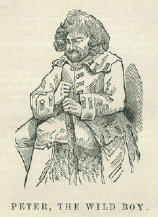
The Curious Tale of Peter the Wild Boy
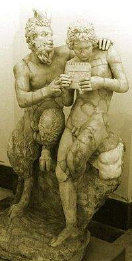
“Pan or the Evil One”
Few neopagan reconstructionist traditions recognize Satan or the Devil outright. However, many neopagan
groups worship some sort of Horned God, for example as a consort of the Great Goddess in Wicca. These gods usually reflect mythological
figures such as Cernunnos or Pan, and any similarity they may have to the Christian Devil seems to date back only to the 19th century,
when a Christian reaction to Pan's growing importance in literature and art resulted in his image being translated to that of the
Devil.

Reports of the Wild/Hairy Man part 2
Yowie / Bigfoot
The Courier (Hobart, Tas.)
Date: September 29, 1843
Page Number: 4
[ADVERTISEMENT.]
CAUTION.--The BABOON haunting the neighbourhood of the Waterloo Tavern," in the dress of a man, is cautioned against aping the foreigner in future--his haunt should be at the upper end of the street--his quackery is not disguised by his cloak. The mischievous "monkey" is advised to let, females pass in quiet, or steps will be taken to tame the creature, by placing him in the cage not far off his beat. He had better recollect, that although he has had one lucky escape, things may turn out adverse to his composition !
September 29.
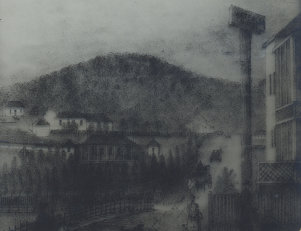
Walker, James Backhouse Lantern Slide of Waterloo Hotel, corner Murray and Davey Streets, Hobart, Van Diemen's Land, 1832. University
of Tasmania Library Special and Rare Materials Collection, Australia.


Contents
Notes and sketches of New South Wales : during a residence in that colony from 1839 to 1844 (1844)
By: Mrs Charles Meredith
Date: 1844
Page Number: 95
…
Although they appear to treat their children kindly when they can in some measure help themselves, yet infanticide
is frequent among the women, who often dislike the trouble of taking care of their babies, and destroy them immediately after birth,
saying that "Yahoo," or "Devil-devil," took them. One woman, whom Mr. Meredith saw a day or two after the birth of her baby, on being
asked where it was, replied with perfect nonchalance, "I believe Dingo patta !" — She believed the dog had eaten it ! Numbers of the
hapless little beings are no doubt disposed of by their unnatural mothers in a similar manner.
I never could
make out anything of their religious ideas, or even if they had a comprehension of a beneficent Supreme Being ; but they have an evil
spirit, which causes them great terror, whom they call “Yahoo," or "Devil-devil :" he lives in the tops of the steepest and rockiest
mountains, which are totally inaccessible to all human beings, and comes down at night to seize and run away with men, women, or children,
whom he eats up, children being his favourite food ; and this superstition is used doubtless as a cloak to many a horrid and revolting
crime committed by the wretched and unnatural mothers, who nearly always, when their infants disappear, say "Yahoo" took them. They
never can tell which way he goes by his tracks, because he has the power of turning his feet in any direction he pleases, but usually
wears them heels first, or, as they express it, “Mundoey that-a-way, cobbra that-a-way" (feet going one way, and head or face pointing
the other). The name Devil-devil is of course borrowed from our vocabulary, and the doubling of the phrase denotes how terrible or
intense a devil he is ; that of Yahoo, being used to express a bad spirit
...

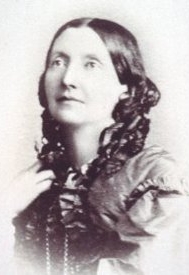
Louisa Ann Meredith (1812–1895)
Cultural Heritage: English
Occupation: autobiographer/memoirist, contemporary-affairs commentator, natural history artist, novelist, poet
Louisa was educated mainly by her mother. She grew up in Birmingham and in the agitation leading to the 1832 Reform Act she learnt 'to think independently and express herself fearlessly on religious and social issues'; later she published several newspaper articles in support of the Chartists. Her first book in 1835 was a collection of poems, with illustrations designed and etched by herself. Undaunted by the pioneering of her first years of marriage, she continued to write and sketch, turning to the observation of colonial life and the study of bush flora and fauna. She published in London Notes and Sketches of New South Wales (1844); her frank comments provoked angry reviews in Sydney but the book was widely read as one of Murray's Colonial and Home Library series.

29-09-2014
Hairy man:
BATHURST, NSW
In 1840 Charles, Louisa and a young son went to Oyster Bay, Tasmania, where his father owned Cambria. They bought an adjoining estate, Springvale, and in August 1842 moved to their newly-built house. Meanwhile news reached them of insolvencies in Sydney which involved the loss of 'all we owned in that colony'. Unable to pay the interest on their mortgages, Charles was appointed police magistrate at Port Sorell in 1844

Although she was living in Tasmania when she published her notes, Meredith wrote about her time in the Bathurst region of New South Wales.
[Corrected: 24.01.2015]
THE BUNYIP, or KINE PRATIE.
The Sydney Morning Herald
Date: January 21, 1847
Page Number: 2
From the earliest date of our intercourse with the aborigines there has always been a traditional rumour amongst them of a creature
hitherto supposed to be fabulous, and many extraordinary stories have from time to time been current as to the conformation and habits
of this animal. Speculation and enquiry have been on the rack to find out, first - whether there was any reasonable foundation for
these traditional rumours; and secondly - supposing the animal to exist, to what genus or species of animals does it belong?
At the Hunter's River the reports of the natives would lead us to classify it with the carnivorous species. In this locality it is
called Yaa-hoo, and is described as having much resemblance in form to the human figure, but with frightful features - the feet like
those of a man, but reversed or turned backwards. In the immediate neighbourhood of the river the animal is called Wowee Wowee, and
the blacks picture its haunts and habits as purely aquatic. It is a fact well known to residents and others near that river that the
aborigines will not readily venture into the deep and dark pools which remain when its bed is partially dried up.
...
Read more:
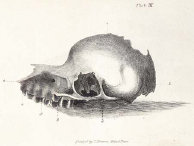
Hairy man
linked to
the Bunyip
Yaa-hoo + Wowee = Yowie ?
24-01-2016
…
In other countries bones of animals known to be extinct are found near the surface, and in a tolerable state of preservation. In
the North Island, the bones of the moa are found frequently in the rivers which flow into Poverty Bay and elsewhere, but, though the
island is populous, and has been traversed in different directions, no trace of a living moa has yet been seen.
When in Molyneux Bay,
we heard a great deal about some animals -said to be beavers, which frequent the lakes at the source of the Molyneux River. So many
persons told us of them, and one very intelligent native who walked with us, and said he had seen them, described their manner of
swimming, and diving, and building houses on the bank, so circumstantially, that it was scarcely possible to doubt that there was
some foundation for the story. These additions to the Fauna of New Zealand — and a floating island which also is said to sail about
on one of these lakes — will, I trust, yet tempt some settler of New Edinburgh to visit the region in which they are found. Behind
Toutuki, be may explore the mountain dreaded by the natives on account of its being the favourite residence of the mairoero. This
is a wild man of the woods, strong, cunning, and mischievous, and addicted to running off with young people and damsels. His body
is covered with coarse and long hair, which also flows down from the back of his head nearly to his heels. To compensate for this
excessive quantity behind, his forehead is said to be bald. He was vividly described to us by a Maori who had seen one long ago, when
he was a little boy, and was of opinion that "there is not a more fearful wild-fowl than your mairoero living." The pukatuola is another
wonderful animal of the southward, told of by the old men. Under a different name he is heard of in the north. A gigantic animal of
the lizard species, most dangerous to humanity. A very shrewd man, whom we met to the southward, was of opinion that these hairy men
and crocodiles had their origin in the Maories seeing pictures of animals in books belonging to Europeans, and then persuading themselves
that they existed in their woods : but I cannot take this view of the case. I would appeal to the actual discovery of the bones of
the moa as a striking instance of corroborating the natives' tales. And I can imagine New Zealand existing under different physical
circumstances, when both large monkeys and crocodiles formed part of its inhabitants; and recognize the far distant tradition of these
surviving (though modified) the lapse of many ages among a people naturally talkative and legend-loving. It will be of the greatest
interest if hereafter the fossil bones of some large monkey or saurian animal should be discovered. The field for such researches
in New Zealand is yet almost unexplored…
NOTES OF A JOURNEY THROUGH A PART OF THE MIDDLE ISLAND OF NEW ZEALAND
Nelson Examiner and New Zealand Chronicle (NZ)
Date: 5 October, 1844
Page Number: 3
23-01-2017


[I]t was commonly, but erroneously, believed that the Moriori were pre-Maori settlers of New Zealand, linguistically and genetically different from the Maori, and possibly Melanesian. By the late 20th century the hypothesis that the Moriori were different from the Maori had fallen out of favour amongst archeologists, who believed that the Moriori were Maori who settled on the Chatham Islands in the 16th century. The earlier hypothesis was discredited in the 1960s and 1970s.
Hairy man:
NEW ZEALAND
1840 to 1847
…
For some time past Mr E. SOLOLON, our worthy townsman, has been annoyed by several coarse and ungentlemanly allusions to his person,
his family, and his religion, which have appeared in the Adelaide Examiner. He has not only been twitted with being a Jew (query,
is his assailant a Christian?) but characterised ; as '"an English scarecrow," compared to "a wild man of the woods," reminded of
the clanking of the felons' chains, and told, in language not to be mistaken, that he had forfeited his position in society, and had
been expatriated at his country's expense !
…
Racism raises its head again, this time using the term "wild man of the woods" in a derogatory manner against a Jewish settler.
The Courrier de Lyon informs us that the mayor of Chantray, in the Rhone, has sent to the procureur du roi, at Villefranche, a man who has for several months been living in the woods, upon no other food than the roots of the earth and some scraps occasionally afforded him by the poorer peasants. In the depth of the winter he availed himself by night of the shelter of cowhouses and other outbuildings left open to him, but always at daybreak made his way back into the coverts. Being found in a weak state, staggering along and supported by a rude staff, his toes and feet being in a gangrenous condition from being frostbitten, he was secured and conveyed to Villefranche. He bears all the appearance of a savage, with thick knotted hair and beard, his face being shrunk and discoloured from want and exposure. He wore a ragged pair of pantaloons, and the fragments of a garment which originally had been trimmed with fur, but now added largely to his unnatural appearance. He seems to have lost the use of his voice, and utters only inarticulate sounds. It is said to have been discovered that his name is Perrier, that he was born at Pont-de-Vaux, in the Ain, about 65 years of age, and that he has practised medicine. What caused his strange abandon ment of society has not yet been learnt.
The Australian (Sydney, NSW)
Date: November 8, 1843
Page Number: 2
THE LIBERTY OF THE PRESS AND THE RIGHT OF PRIVATE JUDGMENT.
South Australian Register (Adelaide, SA)
Date: March 11, 1843
Page Number:
2
Although this is from a novel, it does introduce us to the 19th century notion that apes could be civilised and taught to live as
humans. The dark flip-side to this notion is that "uncivilised" native peoples were often considered to be evolutionary closer to
apes than the contemporary "civilised" European.
Such ambiguity over the terms "wild man" and "wild man of the woods" often lead to
the derogatory association of dark-skinned natives with monkeys/apes that is still in use today.
... 'A Metaphysical Essay, upon the imitative habits and dispositions of the Simia Satyrus, or ourang outang, vulgarly called the wild man of the woods ; and the readiest method of domesticating the race, with the view of ultimately raising the character of the animal to such a point of intelligence as to make it available for the purposes of civilization.'...
(From a Novel called Hardness ; or, the Uncle.)
The Australian (Sydney, NSW)
Date: August 7, 1841
Page Number: 3
SUPERSTITIONS OF THE AUSTRALIAN ABORIGINES: THE YAHOO.
Australia and New Zealand Monthly Magazine
Date: February, 1842
Page Number: 92-96
The natives of Australia have, properly speaking, no idea of any supernatural being ; at the same time, they believe in the imaginary
existence of a class which, in the singular number, they call YAHOO, or, when they wish to be anglified, Devil-Devil...
Yowieocalypse wishes to advise Aboriginal and Torres Strait Islander visitors that this article contains names of deceased people.
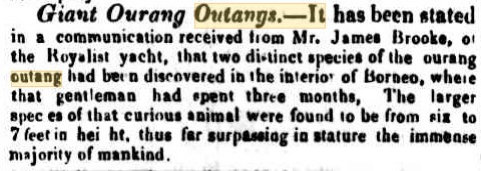
The Sydney Gazette and New South Wales Advertiser (NSW)
Date: July 4, 1840
Page Number: 3
15.01.2017

AUSTRALIA FELIX.
The Australian (Sydney, NSW)
Date: January 2, 1841
Page Number: 2
15.01.2017
The Sydney Gazette and New South Wales Advertiser (NSW)
Date: February 18, 1841
Page Number: 2
...
Much has been written and spoken of the blacks or aborigines of New Holland ; they have been condemned
by one party, unjustly I must say, as possessing all the vices and depravity of our worst nature, together with the malignity of fiends;
and by another as being the most inoffensive and virtuous ; for my own part I must say that neither party are correct in their general
averments.
It must be admitted by every one that they are grossly ignorant, being totally indifferent to,
and indeed professing no belief in, a future state ; the only idea they have, but which I rather suspect they must have derived from
the "whites," relative to another state, is the constant dread they are in of an evil spirit which they call "Gunoure," or debil debil ;
and at night they are so much afraid of stirring abroad from a fear of falling info this imaginary being's power, that no persuasion
will get them to leave their gunheys[?] after nightfall.
...

This article does not mention the Wild or Hairy Man but it does mention the term debil debil - the ubiquitous anglicized
bogeyman of 19th century Aboriginals.
Yowieocalypse has yet to find any further references to "Gunoure" though...
...
In this mode an indefinite number of aliens, without the possibility of their concurrence, for they could not concur in what they
could not comprehend, were suddenly made denizens of the British empire ; made answerable to its complicated laws, before the means
existed for enabling them to obtain any insight, or even a hint of the requirements, nature, or general drift of those laws, or perhaps
even of any single law out of the thousands laid down for their guidance. This would not be fair, even if the highly penal laws of
England were directed simply against what was malum in se, or if the savage could be exempt from every law relating to mere malum
prohibitum; for how can the untutored wild man comprehend what is vicious in itself?
...
A LAW OF COLONISTS AND ABORIGINES
The Australian (Sydney, NSW)
Date: August 7, 1841
Page Number: 3
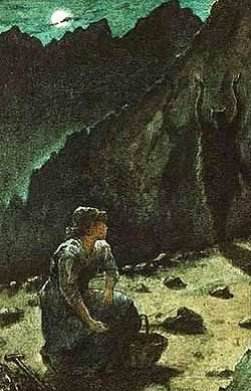


The Amber Witch is a German novel published by Wilhelm Meinhold (1797–1851) in 1838. Its German title is Maria Schweidler, die Bernsteinhexe.
The novel was originally published as a literary hoax which purported to be an actual 17th-century chronicle. Meinhold later admitted
to the hoax but had some difficulty in proving that he was its author. In 1844, it was published in Britain as The Amber Witch in
two English translations ...
14.01.2018


























